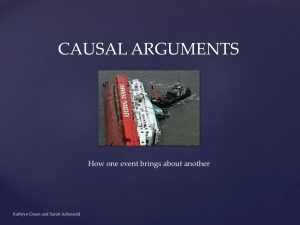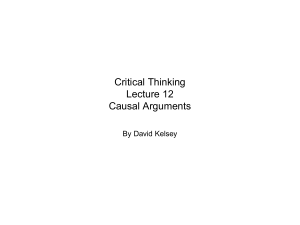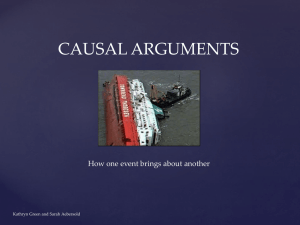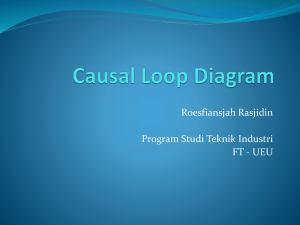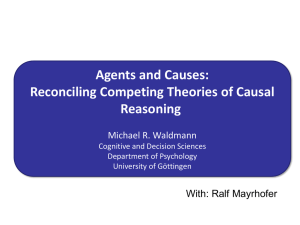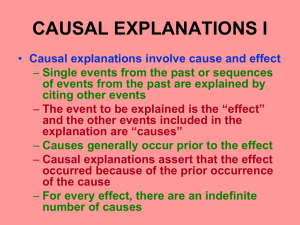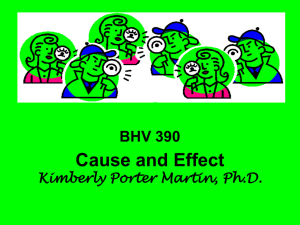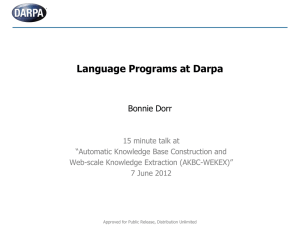independent variable
advertisement
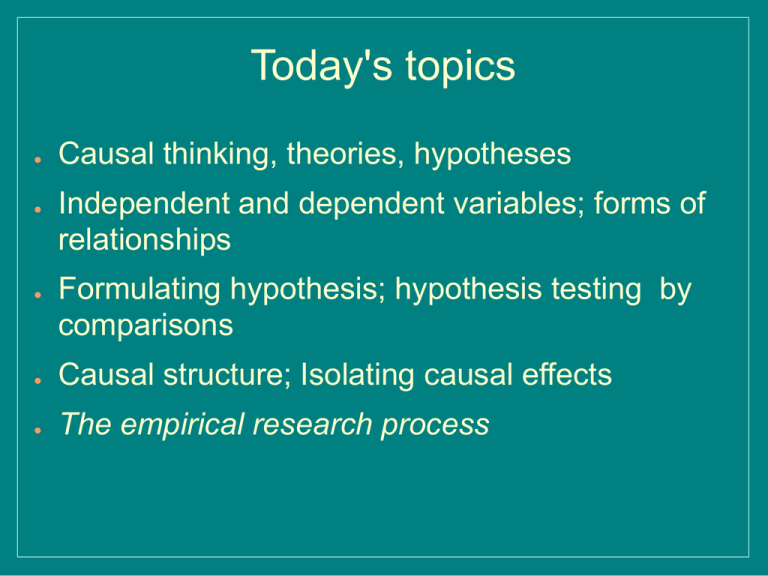
Today's topics ● ● ● Causal thinking, theories, hypotheses Independent and dependent variables; forms of relationships Formulating hypothesis; hypothesis testing by comparisons ● Causal structure; Isolating causal effects ● The empirical research process Causation ● ● ● ● Social scientists systematically observe social life to identify and understand patterns Understanding facilitated by theoretical causal explanations, statements about the underlying causal structure giving rise to observed data. Plausible stories. Other important factors for causation: empirical correlation (not sufficient), temporal ordering, no confounding Deterministic vs. probabilistic causation: – Women more likely to favor gun control – Not every woman favors gun control. Theories and Hypotheses ● ● ● Theories help us make sense of observed data, and guide us in designing future research Not all theories are “good” A “good” theory is not only logically plausible, but suggests testable hypotheses about the empirical relationship between variables representing causes and effects – e.g. Gender and gun control – e.g. People with more education are more likely to vote than people with less education (more education, better informed, higher sense of efficacy). Variables ● ● ● ● “Education”, “turnout”,”gender”, and “gun control opinion” are variables. A variable is a measured concept that takes varying values for different subjects. We distinguish between dependent variable (conventionally denoted by Y) and independent variable (conventionally denoted by X) Dependent variables represent effects, independent variables causes. Dependent and Independent Variables: Example (State Data) ● ● Dependent variable (Y): % voting for Bush in 2004 Independent variable (X): % of the public who were Republican Independent and dependent Variables: More Examples ● Gender and Candidate Preference ● Education and Income ● Party ID and gun control attitude ● Regime Type and Economic Development (this one is hard!) Independent and dependent Variables: forms of relationships ● A relationship can be positive or negative ● A relationship can be linear or nonlinear – ● Linear: effect size constant wherever you look See figures 3-1 to 3-6, pp. 60-66 Hypothesis ● General template: (Pollock p.50) – ● ● In a comparison of [units of analysis], those having [one value on the independent variable] will be more likely to have [one value on the dependent variable] than will those having [a different value on the independent variable] e.g. People with more education are more likely to vote than people with less education Examples of bad hypotheses: p.52. Pollock Hypothesis ● ● A hypothesis suggests a comparison, which is the basis of hypothesis testing Cross tabulation if x and y both categorical – ● Mean comparison if y quantitative – ● e.g. Table 3-1, p.55 e.g. Table 3-3, p.59 correlation/regression – e.g., the scatter plot we've see Causal Structures ● ● ● ● If there were no rival causal explanations, testing hypothesis would be easy But that's not generally the case e.g. May observe correlation between Turnout and Education, Income, Party Identification Questions is whether any of the correlation might be “spurious” that can be “explained away”? Causal Structures ● Education Income Turnout ● Party ID In this hypothetical causal structure, the relationship between income and turnout is spurious, explained away by the common cause of Education Controlling for Education, the effect of income on turnout is no more. Causal Structures ● Education Efficacy Turnout ● Party ID ● In this hypothetical causal structure, the relationship between education and turnout is mediated by Efficacy, an “intervening variable”. Intervening variables help explain how the independent variable causes the dependent variable. What happens if you control for the intervening variable? Causal Structures ● Gender ● Gun control Partisanship In this hypothetical causal structure, the relationship between partisanship and gun control opinion is spurious. Controlling for “gender” --e.g., only look at data on women---you'd see that partisanship no longer matters. Causal Structures ● Gender Gun control ● ● Partisanship In this hypothetical causal structure, the effects of Gender and Partisanship is “additive” . Figure 4-4, p.85, Pollock. Each of the two X's adds to the explanation. Causal Structures ● Gender Gun control Partisanship ● ● In this hypothetical causal structure, the effect of partisanship is interactive, and depends on the value of “gender” Figure 4-6, 4-7, pp.87,88. Pollock. We'll get to the math modeling of this later on Isolating Causal Effects ● ● We usually don't know the true causal structure To test whether some X has a causal effect on Y, ideally we conduct randomized experiments, with a control group and treatment group that are identical (in a statistical sense, same distribution) on everything except the value of that X (we will return to this) – (e.g. Medical experiment, effects of a new drug) Isolating Causal Effects ● Natural experiments may see some differences in the (self selected) treatment and control groups that must be adjusted. – e.g. Different modes of instruction. Students sign up for two different versions of the course, one emphasizes the Internet more than the other. But same instructor, same books, etc. Isolating Causal Effects ● Most often, social scientists must rely on observational data, such as survey data on turnout and other variables. The challenge then is to control for the “right” set of confounding variables, so that the resulting “marginal effect” would represent causal effect. – e.g. Suppose education is the only confounder for the relationship between income and turnout. We ask: among people with the same level of education, is there still a relationship between income and turnout, and how strong? The Empirical Research Process ● ● ● ● ● ● Identify the general topic of interest. (e.g. do drug prevention programs work?) Identify units of analysis (study who? Individuals? Schools?) Conduct literature review: what has been said on this? What would be your contributions? Develop theory (e.g. social influence), and formulate testable hypothesis (e.g. % of students smoking is decreased in the treatment group) Nominal and operational definitions, measurement Data collection (primary or secondary, experimental or observational..) ● Methods/models; data analysis ● Writing up.
